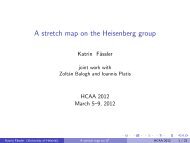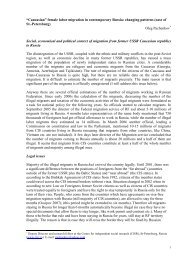THORIUM AS AN ENERGY SOURCE - Opportunities for Norway ...
THORIUM AS AN ENERGY SOURCE - Opportunities for Norway ...
THORIUM AS AN ENERGY SOURCE - Opportunities for Norway ...
Create successful ePaper yourself
Turn your PDF publications into a flip-book with our unique Google optimized e-Paper software.
Thorium as an Energy Source - <strong>Opportunities</strong> <strong>for</strong> <strong>Norway</strong><br />
The HTGR fuel element manufacture process was established in Germany, KFA Jülich and<br />
NUKEM, to make the reactor “pebbles” of about 60 mm diameter <strong>for</strong> the ATR and THTR reactors.<br />
About 650 000 such pebbles were manufactured. The coatings on the HTGR fuel particles operate<br />
at very nearly the same temperature as the fuel, 800 to 1300 ºC. These high temperatures<br />
intensify effects from radiation-induced dimensional changes, fission gas pressure build-up, and<br />
temperature-controlled diffusion processes. The effectiveness by which the fission products are<br />
retained in the different fuels is governed by a complex interrelation between many factors<br />
including radiation damage, swelling, chemical corrosion and composition changes at elevated<br />
temperatures. It can be deduced that, while HTGR carbide fuel can withstand very high<br />
temperatures <strong>for</strong> a long time and high burnup compared with LWR oxide fuel, it is much more<br />
complex and expensive to operate.<br />
4.3 Fuel Properties and Per<strong>for</strong>mance<br />
Considerable experience has accumulated in thorium fuel fabrication. For the Fort St. Vrain<br />
reactor 2448 hexagonal graphite fuel elements, 7.1 million fuel compacts and 26 000 kg of fissile<br />
and fertile material in TRISO-coated fuel particles were produced. This included almost 25 000 kg<br />
of thorium. It was irradiated at temperatures greater than 1300ºC to a maximum burnup in the<br />
fissile particles of 16 per cent fissions in initial metal atoms (FIMA) to a maximum fast neutron<br />
fluence of 4.5·10 25 n/m 2 with no evidence of significant coating failure. Over 50 tonnes of thorium<br />
fuel in ceramic <strong>for</strong>m, clad in Zircaloy, was also manufactured <strong>for</strong> the Shippingport LWBR core.<br />
4.3.1 LWR Fuel Per<strong>for</strong>mance<br />
A number of irradiation tests was per<strong>for</strong>med in water-moderated reactors to evaluate the in-pile<br />
behaviour of various (Th,U)O2 containing fuel rods fabricated by either pelletizing, vipac or<br />
sphere-pac.<br />
Fuel per<strong>for</strong>mance was extensively studied within the Oak Ridge National Laboratory irradiation<br />
program which started in 1961. The initial results on the per<strong>for</strong>mance characteristics were found<br />
to be favourable [38], [39]:<br />
• In general, all thoria based fuels per<strong>for</strong>med better than urania based fuels;<br />
• Sol-gel derived (Th,U)O2 fuels meet the basic per<strong>for</strong>mance requirements of a nuclear fuel;<br />
• Vibration compacted (Th,U)O2 fuel rods per<strong>for</strong>m as well as those containing pressed and<br />
sintered pellets at moderate heat ratings up to 300 W/cm and burnup levels of 40 000<br />
MWd/tHM (Mega Watt days per tonne Heavy Metal).<br />
The work was continued by investigating the per<strong>for</strong>mance of (Th,U)O2 fuel under different test<br />
conditions such as:<br />
• High burnups and moderate heat ratings;<br />
• High burnups and intermediate heat ratings;<br />
• Moderate burnups and high heat ratings;<br />
• Processing variables affecting the irradiation per<strong>for</strong>mance.<br />
Additionally, special irradiation test programs had been per<strong>for</strong>med under the Light Water<br />
Breeder Reactor Program and in the Halden Boiling Heavy Water Reactor [40] and in power<br />
reactors [41]. The behaviour of Th-based fuel in PWRs at heat loads up to 680 W/cm and to<br />
burnups of 80 000 MWd/tHM was studied. The Th-based fuel per<strong>for</strong>med excellently compared to<br />
standard LWR fuel.<br />
36

















